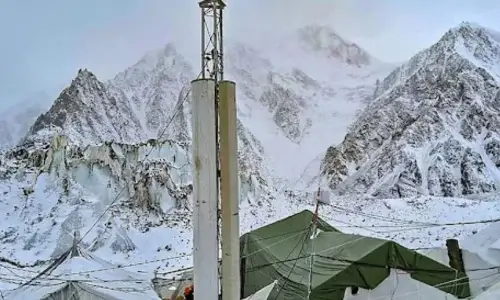In a significant technological advancement, the Indian Army has successfully installed optical fibre cables at two of its most remote and challenging outposts: the Siachen Glacier and Daulat Beg Oldi (DBO) in the Ladakh region. This initiative aims to bolster communication capabilities in these strategic locations, which are known for their extreme weather conditions and strategic importance.
Strategic Significance of Siachen and Daulat Beg Oldi

The Siachen Glacier, often referred to as the world’s highest battlefield, is situated at altitudes ranging from 18,000 to 21,000 feet in the Karakoram mountain range. Since 1984, the Indian Army has maintained a presence in this region to assert control over the glacier and counter strategic threats. Similarly, Daulat Beg Oldi, located at an altitude of approximately 16,700 feet near the Line of Actual Control (LAC) with China, serves as a critical military base for monitoring and securing the northern frontiers.
Challenges of Communication in High-Altitude Regions
Maintaining effective communication in these high-altitude regions has been a persistent challenge due to harsh weather conditions, rugged terrain, and limited infrastructure. Traditional communication methods often face disruptions, impacting operational efficiency and the well-being of personnel stationed in these areas.
The Optical Fibre Initiative
To address these challenges, the Indian Army’s Fire and Fury Corps undertook the ambitious project of laying optical fibre cables across the treacherous terrains of Siachen and DBO. This endeavor involved navigating crevasses, enduring extreme cold, and overcoming logistical hurdles to ensure seamless connectivity at altitudes above 18,000 feet. The successful installation of these cables marks a milestone in enhancing communication infrastructure in some of the world’s most inhospitable regions.
Implications for Military Operations
The introduction of high-speed optical fibre connectivity is expected to significantly enhance the Indian Army’s operational capabilities in these strategic areas. Improved communication will facilitate real-time data transmission, better coordination among units, and more efficient decision-making processes. Additionally, it will support the integration of advanced technologies such as surveillance systems and unmanned aerial vehicles (UAVs), thereby strengthening the overall security framework.
Impact on Personnel Welfare
Beyond operational benefits, the enhanced connectivity is poised to improve the quality of life for soldiers stationed in these remote outposts. Reliable communication channels will enable personnel to maintain regular contact with their families, access educational resources, and stay informed about developments in the outside world, thereby boosting morale and mental well-being.
Broader Context: India’s Focus on Border Infrastructure
This development aligns with India’s broader strategy to strengthen infrastructure along its northern borders. In recent years, there has been a concerted effort to improve road networks, establish advanced communication systems, and deploy modern equipment to enhance the readiness and resilience of forces stationed in these critical areas.
Conclusion
The successful installation of optical fibre cables at Siachen and Daulat Beg Oldi represents a significant leap forward in the Indian Army’s efforts to modernize its communication infrastructure in high-altitude regions. This initiative not only enhances operational efficiency but also underscores India’s commitment to safeguarding its strategic interests in challenging terrains. As technological advancements continue to evolve, such projects will play a crucial role in ensuring the security and well-being of personnel deployed in some of the most demanding environments on the planet.

